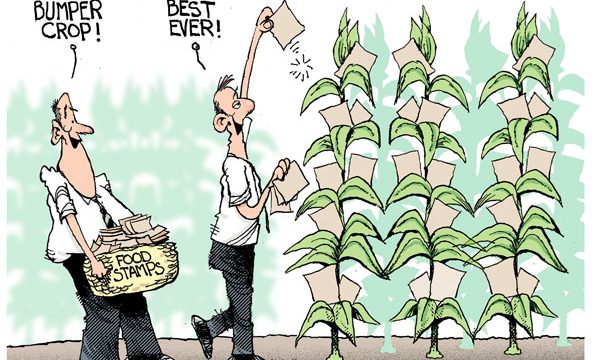The Senate Farm Bill Is 80% Food Stamps

North Dakota’s Republican and Democrat Senators were today applauding the passage of the Senate version of the Farm Bill.
“For the second year in a row, the Senate has voted by a large, bipartisan majority to pass a strong farm bill for American producers and consumers,” Senator Hoeven said in a press release. “It’s strong because we worked hard to make sure it includes enhanced crop insurance, continues the sugar program, provides additional funding for rural flood protection and saves $24 billion dollars to help with the deficit and debt. We also made changes this year that got southern growers onboard, which improves the bill’s chances of passing in the House. Most importantly, it enables our farmers and ranchers to continue to provide American consumers with the highest quality, lowest cost food supply in the world.”
For her part, Senator Heitkamp griped about House Republicans not going along with the Senate’s plans for a farm bill. “Last year, the Senate similarly passed a bipartisan bill, only to have the House of Representatives refuse to take it up. North Dakota producers deserve a long-term bill and it is incumbent upon the House to step up for rural America. Inaction will simply delay needed reforms, prevent smart cuts from taking place and continue unneeded policies that do not reflect the needs of rural America,” she said in a press release.
If House Republicans balk at what the Senate has sent them in terms of a Farm Bill, who could blame them? The bill doesn’t seem to have a lot to do with farming. As this graph from OpenMarket.org shows, the bill is mostly food stamps and conservation programs:

Some have applauded the farm bill saving on spending by eliminating direct-payment farm subsidies, but those have been replaced by an expanded crop insurance program. According to the CBO, the “adverse market payments (AMP)” and “agricultural risk coverage (ARC)” set up by this iteration of the legislation will eat up some 40% of the savings from ending direct payments.
To hear some in politics tell it, you’d think farmers wouldn’t be able to farm without a farm bill, but in truth the bill has become mostly a vehicle for spending that has very little to do with farming, and a vehicle for subsidizing big agribusinesses almost as an afterthought.







